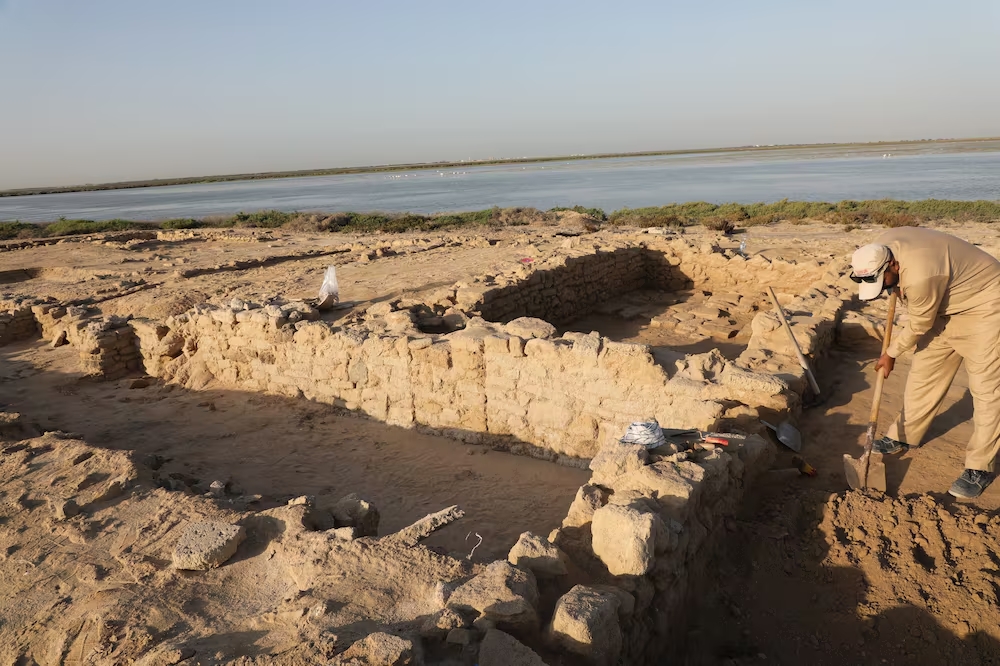

The remains of an ancient settlement have been discovered on the island of Siniya in the Arabian Gulf, belonging to the emirate of Umm Al Quwain (Umm Al Qaywain) in the United Arab Emirates (UAE).
Archaeologists believe they may have found the ancient lost city of Tuam, which was once thought to be the capital of a territory on the Arabian Gulf coast (now the Emirates) and a center for high-quality pearl fishing. At its peak in the 6th century, Tuam was so well-known that it was even mentioned in ancient Arabic texts. After an outbreak of the bubonic plague and a period of instability, the city fell into decline and eventually disappeared. But now historians believe that the island area, where the ruins of a village and a Christian monastery have been unearthed in recent years, may be the location of this lost city.
The work on the site was carried out by the Umm Al Quwain Department of Tourism and Archaeology in collaboration with local and international partners. This season's excavations have uncovered the remains of ancient dwellings - buildings with residential units tightly packed around narrow alleyways, which, according to scientists,indicates a complex settlement with a population of thousands, which was semi-urban and with a system of social classes.
The settlement on Siniya dates back to at least the 4th century. It reached its apogee in the 5th-6th centuries. The city attracted Nestorian monks, who founded a Christian monastery, the second in the territory of the modern UAE, in the late 6th-early 7th centuries. Initially, archaeologists suggested that the settlement could have been a secular community of monks. But after four seasons of work on the site, they are inclined to believe that they have stumbled upon something much more.
"We have discovered the largest settlement ever found on the Arabian Gulf coast," said Professor Tim Power of the University of the UAE. "And it is just the right period for the city described in early Islamic geographical sources. It is clearly a very important place. No one has ever found it."
The settlement covers an area of about 10 hectares. Excavations have uncovered the remains of densely packed buildings. The area of each apartment building is about 30 square meters. According to historians, small stone huts appeared first. As the pearl trade grew, the city expanded with larger houses with luxurious courtyards for wealthy merchants.
A large number of jugs containing date wine, presumably from Iraq, as well as fish bones were found. The results of the excavations indicate that the inhabitants of the city were connected to trade networks that passed through Iraq, Persia and India. This year, jugs with inscriptions in the ancient Aramaic language, the dominant language in the region before the establishment of Arabic, were found.
"It looks like it was a fairly cosmopolitan community with a wide range of trade goods," suggests Professor Power.
This discovery also sheds light on the pre-Islamic history of the region. The city was called Tome in Aramaic and Tuam in Arabic, which means "twins." "Then the word was translated into Greek and English as Thomas, and the original meaning was lost. Therefore, it is believed that the city was named after Saint Thomas, who was sent to the East to spread Christianity," the scientist explained. "In the Western tradition we know him as Doubting Thomas," Professor Power said."But in the East Syrian tradition he is the founding father of Eastern Christianity." Tuam was considered a Christian settlement for about 200 years before the spread of Islam.
Mass burials found in the area of the ancient settlement led historians to the version of the plague. "Mass graves,but there are no signs of trauma on the skeletons, which shows that they did not die a violent death," the professor explains. "Probably the biggest candidate is the plague." Samples of some human remains will be sent for DNA analysis to determine the cause of death of the people. According to some historians, this place could have been affected by the devastating bubonic pandemic - the Justinian Plague, which at one time spread throughout the Mediterranean region.
Overall, the discovery of the ancient settlement on Siniya Island is a significant archaeological find that could help shed light on the history of the UAE and the Arabian Peninsula. The ongoing excavations are expected to provide more information about the city's layout, its inhabitants, and its trade networks.
 Blogs
Blogs
